ISSN ONLINE(2319-8753)PRINT(2347-6710)
ISSN ONLINE(2319-8753)PRINT(2347-6710)
A.K. Goswami1, G. A. Usmani2
|
| Related article at Pubmed, Scholar Google |
Visit for more related articles at International Journal of Innovative Research in Science, Engineering and Technology
The current study is focused on alternative fuel for diesel in the form of soybean oil methyl ester and their different blends with petroleum diesel. The soybean oil is important oil from economic point of view for the biodiesel production and in the country like India this oil is mainly used for edible purpose. The Transesterification process was used to produce the methyl ester from soybean oil. The methyl-ester prepared from soybean oil was blended with diesel fuel such as 10% biodiesel plus 90% Petro-diesel, 20% biodiesel plus 80% Petro-diesel, 30% biodiesel plus 70% Petro-diesel, 40% biodiesel plus 60% Petro-diesel, 60% biodiesel plus 40% Petro-diesel and 80% biodiesel plus 20% Petro-diesel. In the present study, the petroleum analysis of soybean oil, biodiesel (soybeanoil methylester) and its different blends with diesel were done and studied. Properties such as fire and flash point, pour point, aniline point, diesel index, specific gravity and cetane number were determined and also distillation characteristics consisting of initial boiling point and final boiling point were also be studied.
Keywords |
| Aniline Point, Biodiesel, Diesel Index, Kinematic Viscosity, Soybean Oil, Transesterification. |
INTRODUCTION |
| Energy and Fuelare the key aspects for mechanical, modern, social and temperate advancement of any country. Reduction in fossil reserves and higher costing are bringing about a developing requirement for substituting the ordinary fossil fuel with powers inferred from vegetable source otherwise called biodiesel [1 – 4]. Biodiesel is an alternative fuel which is derived from biomass. Biodiesel is obtained from the transesterification of fats and oils and this biofuel has a comparable properties to that of diesel fuel acquired from petroleum source [5 – 7]. One of the fundamental benefit of biodiesel is that it is biodegradable in nature and might be utilized without adjusting or modification in the current motors or engine and likewise delivers minimum pollutant gas in the exhaust gas discharges [8 – 12]. An additional essential thing of biodiesel is that it is miscible with diesel and might be very effectively mixed [13]. The requirement of any fuel that it must be actually and naturally achievable, satisfactory and monetarily aggressiveto give the fuel performance [14]. The transesterification processyields to the biodiesel production by large alludes to a catalyzed synthetic reaction of a vegetable oil and liquor to results in an unsaturated fat alkyl ester and glycerolas byproduct[15]. The unsaturated fat alkylester or any unsaturated fat methyl or propyl ester (otherwise known as FAME) is the biodiesel [16, 17]. This is a reversible reaction, in which excess amount of liquor is utilized to give a maximum yield. Most of the reactions, methanol is the most favorable liquor due to having low comparative cost along with suitable physical and chemical properties. |
| Soybean oil has a good nutritious quality. It holds around 20% oil and 40% protein (as against 7.0 % in rice, 12 % in wheat, 10% in maize and 20-25% in different beats). Soybean protein is rich in significant amino acid lycine (5%). It holds a excellent measure of minerals, salts and vitamins (thiamine and riboflavin) and its grains in growing stagecontains Vitamin C, Vitamin A in sufficient quantity. Soybean oilis the less expensive and possessingbest quality proteins and fats.Soybean oil is the second most widely used vegetable oil after palmoil. Palm and soybean oils together constitute approximately 68% of global eatable oil.Only Soya bean oil constituting around 22.85%. In the recent decade, volume of Soybean oil traded has developed at the rate of 4.05% which indicates around 25% of the global aggregate oils and fats production. Brazil, China,Argentina, and India alongside USA are the significant contributorsof soybean oil for the development. India is the World's biggest shipper of edible oils in the World, of an aggregate 5.0-5.5 million tons of vegetable oils of foreign made, 1.3-1.5 million tons is Soya bean oil. Unrefined and Refined soybean oils are permitted to be imported into India at an import obligation of 45% and 50.4% separately. Indian consumable oil business environment is most value touchy in nature. The climatic necessities for soybean practically the similar to maize. A temperature of 26.5 to 30 0C seems, by all accounts, to be the ideal for the majority of the assortments. Soil temperatures of 15.5 0C or above favorable for germination and energetic seedling development. The base temperature for compelling development is around 10°C. A lower temperature than 10°C, has a tendency to delaying of the blooming. [Ministry of Agriculture, India]. |
METHADOLOGY |
| The soybean oil has been utilized for preparation of biodiesel (alkyl ester of soybean oil). In a measuring cylindersome pellets of potassiumhydroxide is taken and methanol is made to react as demonstrated by stoichiometricproportion. The catalyst pellets was well shaked and blended with the methanol. Atthe opening of the flask, the stirrer is properly fitted. The oil was heated to 60 0C to remove moisture content and the mixed with potassium methoxide.The mixture heated continuously at 65 0C. After two hours, the response of reaction mixture changed to a turbid orange tan color.The sweet smell of the reaction mixture was observed which representing the finishing stage of reaction.The process was continued for another ten to fifteen minutes.The two layers was formed, one is ester and another one is glycerol.In the ester phase, certain amount of unreacted methanol,removed by passing 100 to 150 ml of warm water. The glycerol, methanol was separatedwhile the ester phase hold little measure of water.Water is removed by passing ester through Ca(OH)2 pellet. The methyl ester of pure soybean oil was obtained. This soybean oil methyl ester was blended with diesel fuel in various proportions and the various analysis such as acid value, specific gravity, density, kinematic viscosity, aniline point, cloud point, pour point, flash point and cetane number was studied and results were compared with the standard values of specification of the diesel fuel. |
STUDY OF VARIOUS PROPERTIES OF BIODIESEL |
| 1. Kinematic viscosity determination: |
| The acceptable range ofkinematic viscosity for diesel fuel at 400C to be 2.5 to 7.5 cS as prescribed by BIS standards. For pure soybean oil,the kinematic viscositywas found, 7.54 cS which is slightly above the required range while the pure diesel has a kinematic viscosity of 2.75 cS and pure soybean oil biodiesel has a kinematic viscosity of 6.22 cS, which is comparatively higher but within the range.The viscosity of 10%, 20%, 30%, 40%, 50%, 60%, 80% blends of methyl ester of pure soybean with diesel are 3.02, 3.35, 3.61, 4.12, 4.85, & 5.71 centistokes respectively.The viscosity of biodiesel blends from 10 to 30% were between 3 and 4 cS.This results represents these blends are highly favorable as per the proper ignition due to lower values of viscosity.These lower blends are capable to fulfil the demand of alternative fuel by saving diesel and effectively utilized for better performance of diesel engine. |
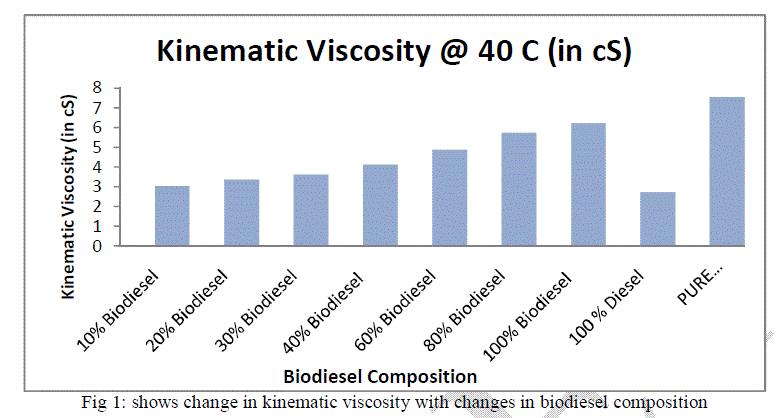 |
| 2. Diesel Index: |
| Diesel index is an indicator of the good ignition quality of diesel fuel. The diesel index for diesel has to be 45 min.as per BIS standards. |
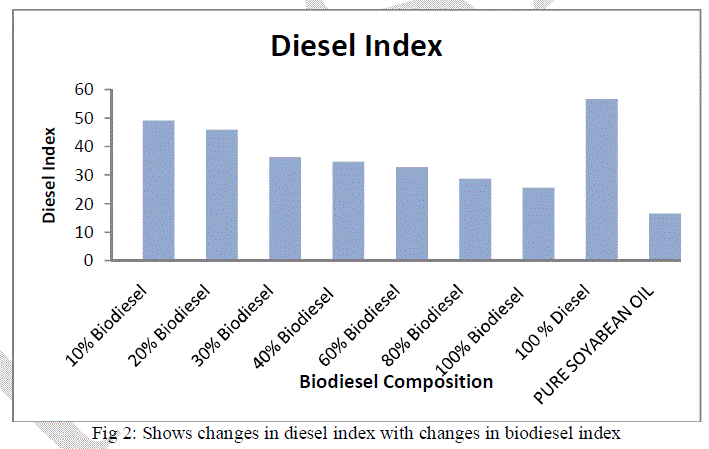 |
| The diesel index of pure soybean oil is 16.6 which is low whereas diesel has a diesel index of 56.63 minutes. While the soybean oil methyl ester, diesel index was found 25.5 which was much lower than diesel. Thus use of pure soybean methyl ester as a fuel will result in a very poor ignition quality. Hence, pure soybean oil methyl ester cannot be used as a fuel alone and blending of biodiesel is preferred with petro diesel. Blend of 10% and 20% methyl ester of pure soybean oil have Diesel Index of 49.17 and 45.86 respectively, which are above the BIS value for diesel index and thus these blends will have superior ignition quality. Other blends of 30%, 40%, 60% and 80% have a lower diesel index as a result causes a poor ignition. As the percentage of blends increase, decrease in the Diesel Index values was observed.So the 10 and 20% blends are most favorable. |
| 3. Aniline Point: |
| When the fuel is highly paraffinic it results in high Diesel Index, hence resulting in high aniline point, which is an indication of superior ignition properties. Evaluation of aniline point is important in determining the diesel index. The various aniline points for various blends have been shown in the graph. |
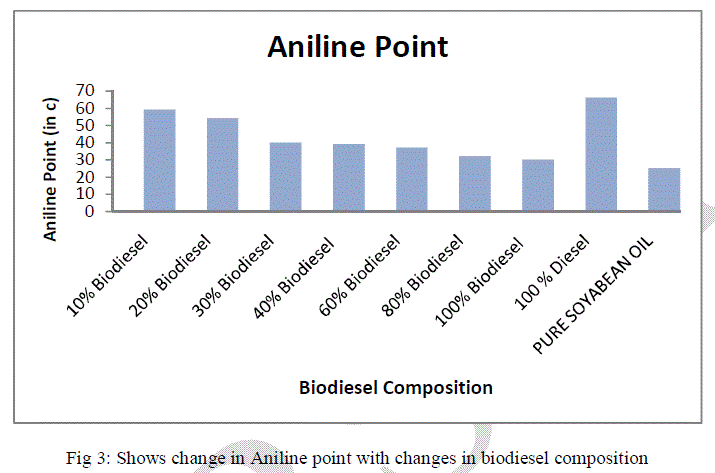 |
| High speed diesel i.e. 100% diesel has an aniline point of 66 0C whereas 100% biodiesel has a much lower aniline point of 25 0C. The blends of pure soybean methyl ester and high speed diesel have a comparatively higher aniline point when compared to high speed diesel but still less than pure biodiesel obtained from the pure soybean oil. |
| 4. Pour Point: |
| Pour point is the lowest temperature at which it has utility in certain application. BIS Specification for max pour point is +6 0C and the market purchased diesel has a pour point of +5 0C and it thus meets the requirements Pour point of pure soybean oil is -6°C which is far below the requirements thus using pure soybean oil as a fuel is of no problem from pour point aspects. Pour point of methyl ester of pure soybean oil (100%) and 10%, 20%, 30%, 40%, 60% and 80% blends of methyl ester of pure soybean oil with diesel are 2°C, 4°C, 3°C, 3°C, 3°C, 2°C and 2°C respectively and are within the specified range given BIS. Thus increasing amount of biodiesel decreases the pour point of biodiesel. Blending above 20%biodieselis not permissible because diesel index does not satisfy the requirement which is much important than pour point and kinematic viscosity. |
| 5. ASTM Distillation Properties: |
| As per BIS specification of diesel 90% distillate temperature should below 366 0C. ASTM distillation of soybeanoil is not possible because of cracking that takes place at higher temperature. Thus considering ASTM characteristics, kinematic viscosity and diesel index as a property we cannot use pure oil in the diesel engine as per the standard properties specification. The graph for ASTM Distillation for Initial Boiling Point, Final Boiling Point and for 90% recovery is as shown below: |
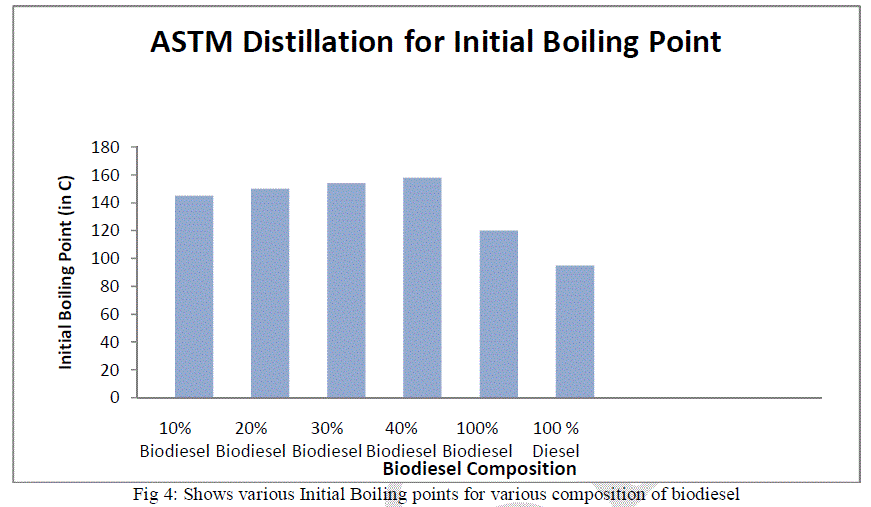 |
| For Initial Boiling Point, temperature of 95 0C is obtained for 100% diesel whereas temperature of 120 0C is obtained for 100% biodiesel. ASTM Distillation for Final Boiling Point is shown by the graph below: |
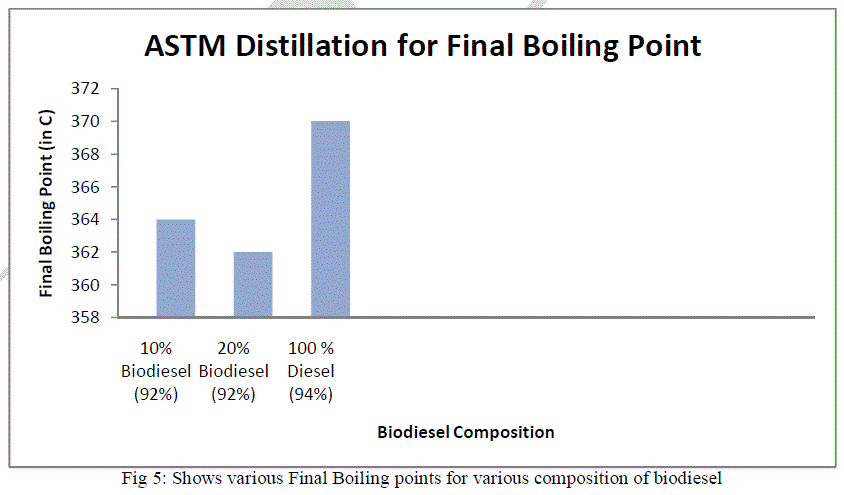 |
| From the graph we can categorically conclude that for both 10% biodiesel and 20% biodiesel similar distillate amount of 92% is obtained for almost similar temperatures. For blends above 20%, cracking take place and FBP is not obtained. |
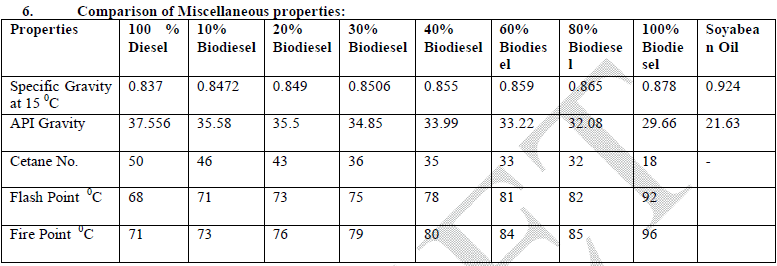 |
CONCLUSIONS |
| Utilizing immaculate soybean oil, it is observed that the diesel motor won't work legitimately because of high kinematic consistency & real contrasts in diesel record and ASTM refining properties. Percentage methyl ester of soybean oil meets the kinematic viscosity and pour point properties according to BIS determination. However properties like ASTM Distillation and diesel index does not meet the detail which is more imperative. In this manner utilizing 100% methyl ester of soybean oil in diesel motor is unrealistic. Blends of 10% and 20% methyl ester of soybean oil with diesel meet the kinematic viscosity, pour point, diesel index and ASTM refining temperatures according to BIS particular. Utilization of 10% blend is the most acceptable whereas 20% and 30% blend produces a satisfactory result. Comparing the other important properties of 10% blend viz. Aniline Point, Diesel Index et al, we observe that the results are strikingly similar to high speed diesel properties. We can conclude that the 10% blend thus obtained is a feasible alternative fuel. |
References |
|